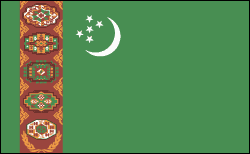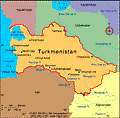Turkmenistan | Facts & Information

- Turkmenistan Profile
- History
- News and Current Events
Infoplease has everything you need to know about Turkmenistan. Check out our country profile, full of essential information about Turkmenistan's geography, history, government, economy, population, culture, religion and languages. If that's not enough, click over to our collection of world maps and flags.
Facts & Figures
-
President: Serdar Berdimuhamedow (2022)
Total area: 188,455 sq mi (488,100 sq km); land area: 181,440 sq mi (469,930 sq km); water area: 7,015 sq mi (18,170 sq km)
Population (2022 est.): 5,636,011 (growth rate: 0.99%); birth rate: 17.51/1000; infant mortality rate: 37.62/1000; life expectancy: 71.83; density per sq mi: 27.1
Capital and largest city (2022 est.): Ashgabat, 883,000
Other large cities: Turkmenabat, 234,817; Dasoguz 166,500
Monetary unit: Manat
Languages: Turkmen (official) 72%; Russian 12%; Uzbek 9%, other 7%
Ethnicity/race: Turkmen 85%, Uzbek 5%, Russian 4%, other 6% (2003)
Religions: Muslim 93%, Christian 6.4%, Buddhist <1%, folk religion <1%, Jewish <1%, other <1%, unspecified <1% (2020 est.)
Literacy rate: 99.7% (2015 est.)
Economic summary: GDP/PPP (2019 est.): $92.33 billion; per capita $15,500. Real growth rate: 6.5% (2017 est.). Inflation: 8%. Unemployment: 11% (2014 est.). Arable land: 4.1%. Agriculture: cotton, grain, melons; livestock. Labor force: 2.305 million (2013 est.); agriculture 48.2%, industry 14%, services 37.8% (2004 est.). Industries: natural gas, oil, petroleum products, textiles, food processing. Natural resources: petroleum, natural gas, sulfur, salt. Exports: $7.458 billion (2017 est.): gas, crude oil, petrochemicals, cotton fiber, textiles.Major trading partners (exports): China 82% (2019). Imports: $4.571 billion (2017 est.): machinery and equipment, chemicals, foodstuffs. Major trading partners (imports): Turkey 25%, Russia 18%, China 14%, Germany 6% (2019).
Communications: Telephones: main lines in use: 717,000 (2020); mobile cellular: 9.377 million (2018). Radio broadcast stations: broadcast media is government controlled and censored; 7 state-owned TV and 4 state-owned radio networks; satellite dishes and programming provide an alternative to the state-run media; officials sometimes limit access to satellite TV by removing satellite dishes (2007). Radios: 1.225 million (1997). Television broadcast stations: 3 (much programming relayed from Russia and Turkey) (1997). Televisions: 820,000 (1997). Internet Service Providers (ISPs): 714 (2012) Internet users: 1,247,940 (2022).
Transportation: Railways: total: 5,113 km (2017). Highways: total: 58,592 km; paved: 47,577 km; unpaved: 11,015 km (2002 est.). Waterways: 1,300 km (Amu Darya and Kara Kum canal are important inland waterways) (2011). Ports and harbors: Turkmenbasy Airports: 26 (2021).
International disputes: Cotton monoculture in Uzbekistan and Turkmenistan creates water-sharing difficulties for Amu Darya river states; field demarcation of the boundaries with Kazakhstan commenced in 2005, but Caspian seabed delimitation remains stalled with Azerbaijan, Iran, and Kazakhstan due to Turkmenistan's indecision over how to allocate the sea's waters and seabed; bilateral talks continue with Azerbaijan on dividing the seabed and contested oilfields in the middle of the Caspian.









